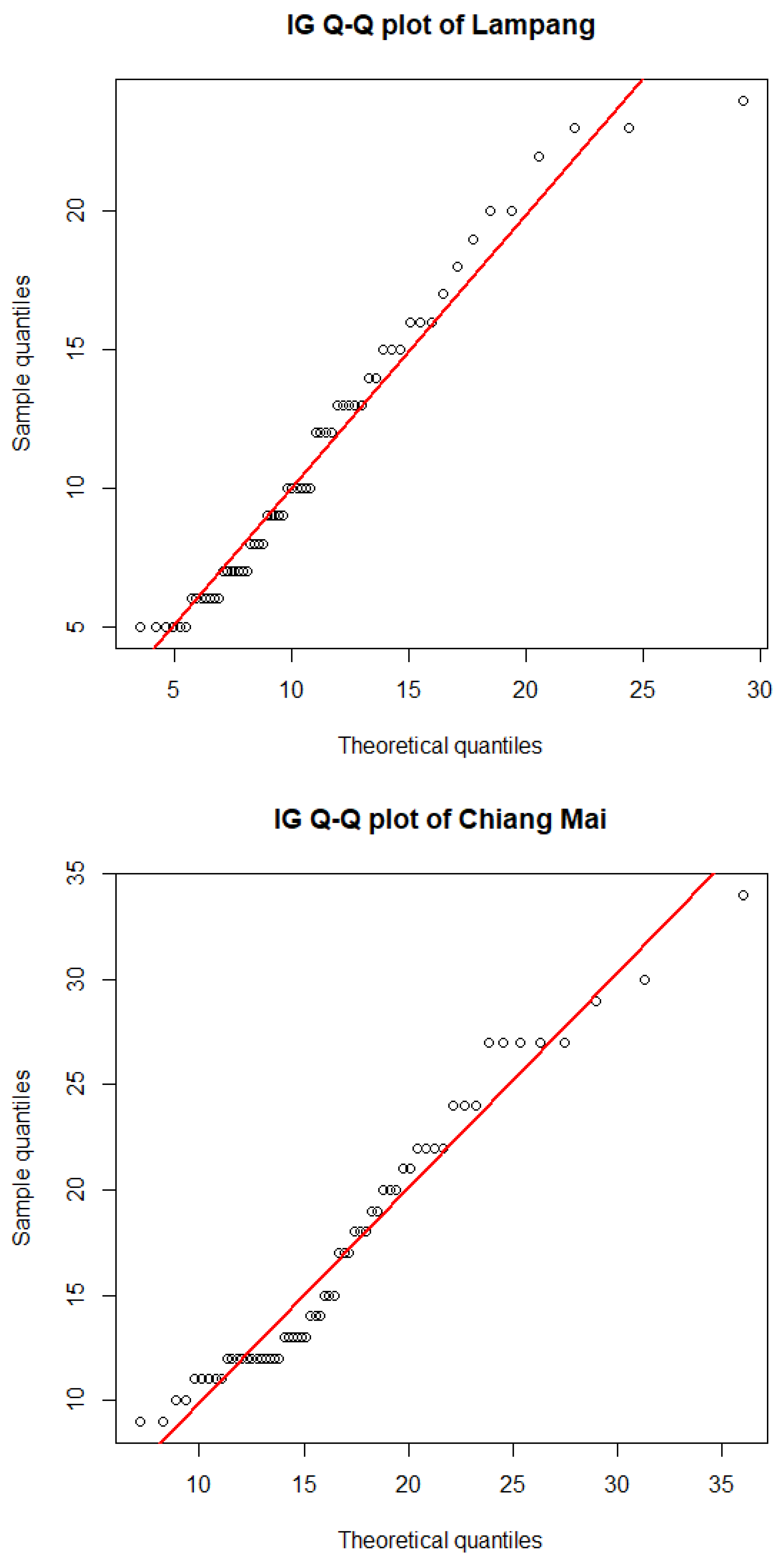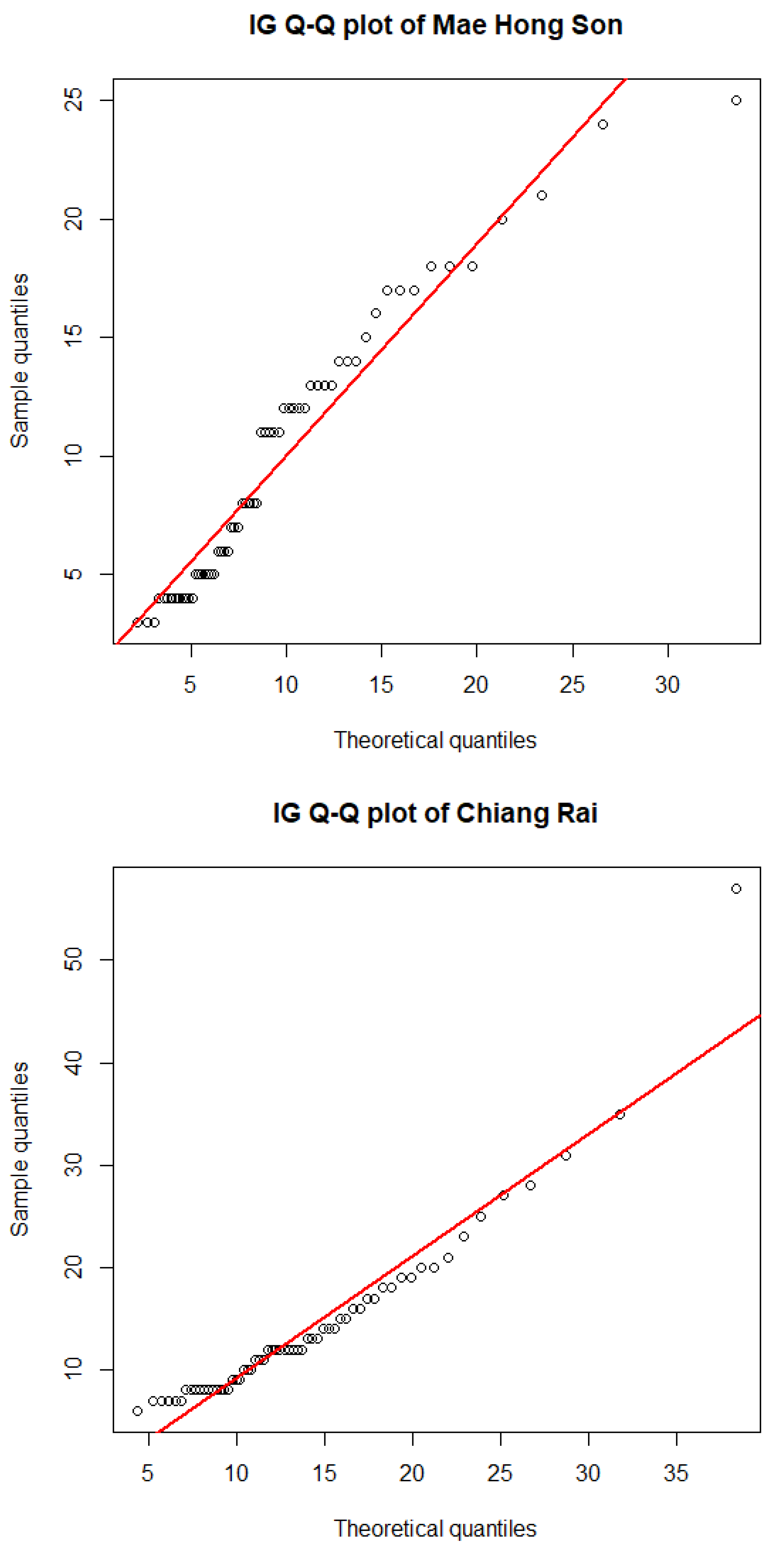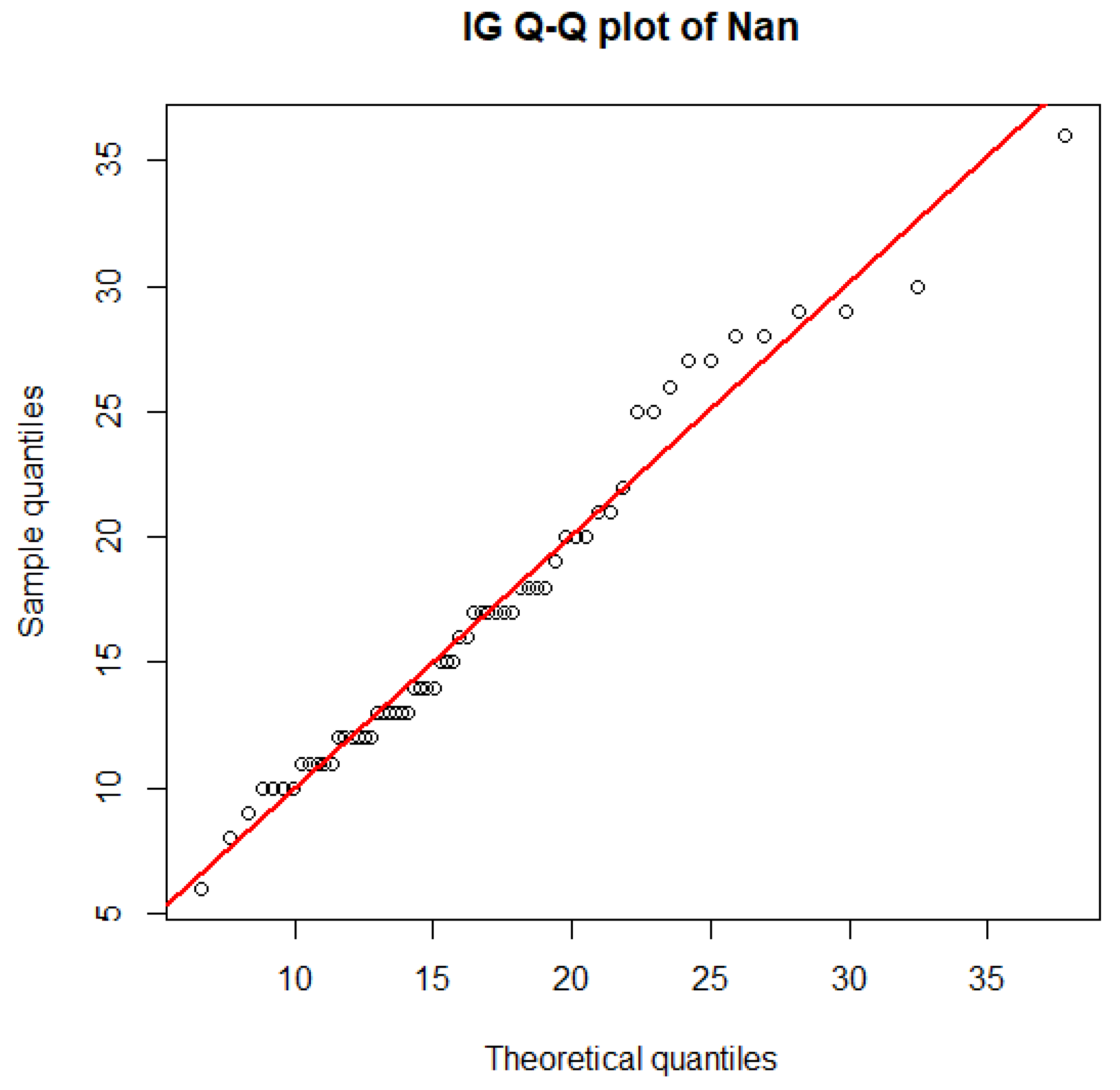1. Introduction
The inverse Gaussian (IG) distribution (also known as the Wald distribution) is a probability distribution with widespread applications across diverse disciplines. It is characterized by asymmetry and versatility in modeling complex real-world phenomena. Notably, the IG distribution exhibits a skewed nature, featuring a protracted right tail, rendering it particularly suitable for scenarios where events follow a pattern of frequent occurrence followed by a gradual decline. A significant theoretical underpinning of the IG distribution lies in its association with Brownian motion. Chhikara and Folk [
1] proposed its application to lifetime modeling, and it has been utilized in various fields such as biology (Hsu et al. [
2], Jerves-cobo et al. [
3]), pharmacokinetics (Weiss [
4]), cardiology (Chaubey [
5]), demography (Ewbanks [
6]), and finance (Balakrishna [
7], Punzo [
8]). In addition, it has been applied to particulate matter (PM) data conforming to an IG distribution. For example, Karaca et al. [
9] investigated the cyclic patterns in the monthly average concentrations of
(PM < 10 µm) and
(PM < 2.5 µm). Feng et al. [
10] investigated the association between daily
levels and the risk of illness in Beijing by utilizing a generalized additive model. Gavriil et al. [
11] examined probability distribution functions applied to
and
concentration data gathered over two years at a central location in Athens; based on goodness-of-fit measures, they identified the most suitable probability density functions as Pearson types VI and V, IG, and lognormal. Confidence intervals (CIs) for functions of the coefficient of variation (CV) of an IG distribution have been proposed. Hsieh [
12] analyzed inferences on the CV of an IG distribution by using likelihood ratio testing. Gupta and Akman [
13] estimated the square of the CV of a weighted IG distribution. Chaubey et al. [
14] investigated the properties of variance stabilizing and symmetrizing transformations for the CV of an IG population. Wasana et al. [
15] determined the CIs for the CV of an IG distribution by employing the generalized CI (GCI), adjusted GCI, bootstrap percentile, fiducial CI (FCI), and highest posterior density (HPD) FCI methods.
The simultaneous CI (SCI) is a statistical tool used to estimate the CIs for multiple instances of a distribution function simultaneously to achieve a more comprehensive understanding of data variability. Researchers often need to analyze several parameters simultaneously in various fields, including science, medicine, and economics. For instance, Hannig et al. [
16] utilized the notion of fiducial generalized pivotal quantities (GPQs) to provide simultaneous fiducial GCIs for the mean ratios of lognormal distributions. Tian et al. [
17] determined the SCI for differences in the medians of multiple independent lognormal distributions by employing the parametric bootstrap, normal approximation, the method of variance estimates recovery (MOVER), and GCI approaches. Abdel-Karim [
18] suggested the MOVER method for constructing the SCI for the ratios of the means of multiple lognormal distributions. Yosboonruang et al. [
19] provided an SCI for all pairwise differences among the CVs of delta-lognormal distributions by employing the fiducial GCI, Bayesian, and MOVER methods. La-ongkaew et al. [
20] constructed the SCI for differences in the means of several Weibull distributions by utilizing the GCI, MOVER, and Bayesian approaches. Kaewprasert et al. [
21] calculated the SCI for the mean ratios of multiple zero-inflated gamma populations based on MOVER, fiducial GCI, and Bayesian and HPD interval methods with either the Jeffreys’ rule or uniform prior. Zhang [
22] investigated the SCI for pairwise comparisons of the means of IG distributions by utilizing fiducial GPQs for the vector parameters.
SCIs have frequently been used to estimate differences in the parameters of various distributions, including lognormal, delta-lognormal, Weibull, delta-gamma, and IG distributions. Moreover, since the SCI for the ratios of the CVs of multiple IG distributions, which is important to measure non-unit data with diverse clusters, has not previously been reported, our aim was to fill this research gap. Herein, we provide methodology involving the GCI, Bayesian, fiducial, and MOVER methods to this end.
2. Methods
For
p populations of observations, let
be random samples from an IG distribution with mean
and variance
. The probability density function is given by
Moreover, the respective maximum likelihood estimators (MLEs) for
and
representing the mean and shape parameters of an IG distribution can be determined as follows:
Equation (
2) can be rewritten as
where
denotes a Chi-square distribution with
degrees of freedom and
and
represent comprehensively sufficient and independent statistics.
The CV (a measure of relative variability) is the ratio of the standard deviation to the mean. For an multiple IG distributions with parameters
and
,
denoting the CV can be calculated as
The aim of the present study is to construct the SCI for the ratios of the CVs of multiple IG populations as follows:
where
denotes the ratios of the CVs for
and
.
By substituting
and
in Equations (2) and (3) with their respective MLEs, one can establish the SCI for the ratios of the CVs of multiple IG populations as follows:
where
and
.
2.1. The GCI Approach
Weeranhandi [
23] was the pioneer who introduced the GCI, a specific category of the GPQ. Let
be a random sample from an IG distribution with parameters
across
p independent samples and assume that observations
. The corresponding GPQ exists if it satisfies the following two requirements:
The distribution conditioned on each is parameter-free.
The observed values of comprise the parameter of interest.
Using the MLEs of
and
in Equations (2) and (3) and in accordance with Ye et al. [
24], the respective GPQs for
and
become
and
where
are the observed values of
and
denotes the approximation of the normal distribution
according to Theorem 2.1 in Chhikara and Folks [
25]. Hence, the GPQ for the ratio of two independent CVs can be written as
Therefore, the
two-sided SCI for
based on the GCI approach can be written as
, where
and
are the
th and
th quantiles of
, respectively, leading to
Algorithm 1 details the process of calculating the SCI using the GCI method. Performing 2500 iterations is essential for validating the accuracy of the code and ensuring its stability across different levels of functionality.
| Algorithm 1: The GCI method |
Compute and for a given sample from an IG distribution. Generate and from Chi-square and standard normal distributions, respectively. Compute and using Equations (7) and (8), respectively. Calculate the from Equation ( 9). Repeat Steps 2–4 2500 times. Complete and .
|
2.2. The Bayesian CI (BCI) Approach
Bayesian inference is the process of updating prior beliefs based on new evidence to obtain a posterior probability. For random samples
from
, the joint likelihood function can be written as
Using Bayes’ theorem to estimate the posterior distribution, we obtain
where
and
are the prior distributions for
and
, respectively. Through the utilization of the second-order partial derivative of the log-likelihood function concerning the unknown parameters, the Fisher information matrix for said parameters can be formulated as follows:
The subsequent subsections cover the employment of the Jeffreys’ rule prior to construct the SCI and simultaneous HPD intervals. The Bayesian methodology for the IG distribution relies on parameter selection. Instead of using the mean directly, it is more convenient to employ the reciprocal of the mean and consider
, where
serves for the parametrization. This choice facilitates the derivation of manageable expressions for both the joint and marginal posterior distributions. Utilizing the Jeffreys’ rule prior generates proper posteriors when assuming both parameters are unknown. Consequently, this approach enables a flexible comparison with the alternative fiducial approach presented by Amry [
26], and eliminates the need for assuming the prior. Although opting for a natural conjugate prior appears to be a viable alternative, this presents challenges in selecting values for its hyperparameters. The choices made in this regard can potentially introduce bias in the inference, thereby favoring the Bayesian perspective over the fiducial one. Using the Jefferys’ rule prior, the marginal posterior distributions for both
and
can, respectively, be derived as
and
where
;
is the cumulative distribution function for the standard normal distribution; and
and
are the MLEs of
and
, respectively, given that all of the observations are considered in Equation (
2). In the present work, we assume that both
and
are unknown. Gibbs sampling, which relies on the Monte Carlo Markov Chain (MCMC) method, was used to determine the posterior and fiducial distributions of the parameters [
27]. It is commonly used to generate samples from the posterior distribution in Bayesian methodology by sweeping through each variable to sample from its conditional distribution with the remaining variables fixed at their current values. In the Gibbs sampler, convergence of the sampled data is guaranteed using both numerical and graphical summaries. Subsequently, by substituting for
and
, we obtain
Therefore,
is given
Therefore, the
SCI and the simultaneous HPD intervals for
based on the BCI method are
where
and
are the lower and upper bounds of the intervals, respectively. We computed
and
using
in the R software package version 4.2.2 to determine the
simultaneous HPD intervals for
, defined as
The value of can be estimated using the following algorithm.
2.3. The FCI Approach
Fiducial inference was first introduced and studied by Fisher [
28]. Under the framework of fiducial inference, parameters are treated as random variables and their distributions (i.e., the fiducial distributions) are produced based on the observed data without assuming prior distributions. Furthermore, according to the fiducial distributions, random samples are generated based on the point and interval estimations of unknown parameters and the MLE. Although challenging, applying the fiducial method to an IG distribution, particularly in conjunction with an MCMC, can be achieved for the parameters of an IG distribution as follows:
and
where
and
are the MLEs of
and
, respectively.
The Gibbs sampler procedure detailed in Algorithm 2 was utilized to sample from the fiducial distribution. Furthermore, a concurrent process for fiducial estimates was carried out by replacing the Bayesian posterior with the fiducial distribution during Step 3 of the Gibbs sampling procedure. After this, the fiducial distribution for
can be obtained as follows:
Following this, the fiducial distribution for
can be defined as
Therefore, the
SCI and simultaneous HPD intervals for
based on the FCI method are
where
and
are the lower and upper bounds of the intervals, respectively. We computed
and
using
in the R software package to determine the
simultaneous HPD intervals for
using the following relationship:
| Algorithm 2: The BCI and HPD.BCI methods |
Calculate MLEs and from the IG distribution and set and in Equation ( 2). Generate and from their respective posterior distributions given in Equations (14) and (15) with the updated sample observations. Repeat Steps 2 and 3 starting with the current values of and for t () iterations, where t is the quantity of MCMC replications, and conclude with the results for and . Calculate the desired parameters after burning in 1000 samples. Calculate the 95% SCI using the BCI method in Equation ( 17). Compute using in the R software package.
|
2.4. The MOVER Approach
In this section, we briefly describe the concept of the MOVER for constructing confidence intervals. The underlying principle of the MOVER involves initially deriving distinct confidence intervals for two individual parameters, subsequently restoring the variance estimates and finally constructing the confidence interval for the desired function of parameters, such as
. This methodology is based on the central limit theorem. Our attention in this paper is specifically directed towards establishing a confidence interval for the parameter related to the ratio function. According to Donner and Zoo [
29], the confidence interval for
is formulated as follows:
and
where
and
are the point parameters and
and
are the confidence intervals for
and
. When considering
p parameters, the lower and upper bounds of the
two-sided SCI for
,
and
can be expressed as
and
for
and
. The parameters of interest in
are
and
, for which constructing CIs is achievable. Based on the approach by Gulhar et al. [
30], let
and
be the lower and upper bounds of the CIs of
, respectively, expressed as follows:
and
The
two-sided MOVER SCI for
is
where
and
are defined in Equations (28) and (29), respectively.
| Algorithm 3: The MOVER |
Generate random samples with sample size from an IG distribution and calculate with sample size from an IG distribution and calculate . Generate and . Calculate and for from Equations (30) and (31). Compute and by using Equations (28) and (29), and calculate the 95% SCIs for .
|
2.5. The Simulation Study
We compared the efficacies of the SCI construction approaches via a Monte Carlo simulation study based on 5000 runs. The comparison was made in terms of the coverage probability (CP) and average length (AL). The best-performing method attains a CP equal to or greater than the nominal confidence level of 0.95 together with the shortest AL. In the study, 2500 GPQs were generated for the GCI method and 20,000 iterations with a burn-in of 1000 were utilized for Gibbs sampling in conjunction with the MCMC algorithm for the Bayesian and HPD approaches. In addition, the sample sizes utilized were or the number of populations was 3 or and
2.6. Empirical Application of the Approaches to Datasets from Northern Thailand
Datasets of the average daily
concentrations from May to June 2022 in Lampang (N1), Chiang Mai (N2), Mae Hong Son (N3), Chiang Rai (N4), and Nan (N5) in northern Thailand were utilized to assess the effectiveness of the proposed methods in constructing the SCI for the ratios of the CVs of multiple IG distributions, the details for which can be found in
Table 1 [
31]. As the
datasets contain positive values, they could be modeled using a lognormal, Cauchy, exponential, Weibull, or IG distribution. Hence, the minimum Akaike information criterion (AIC) and Bayesian information criterion (BIC) were used to identify the best-fitting distribution for these data. The summary statistics for the
concentration datasets from the five provinces in northern Thailand are reported in
Table 2.
4. Discussion
Wasana et al. [
32] utilized the FCI and HPD.FCI methods to construct CIs for the ratio of the CVs of two IG distributions. Examination of the efficacies of these methods revealed that HPD.FCI is the most suitable in this scenario. Building on this idea, we developed estimates for the SCI for the ratios of the CVs of multiple IG populations. The results reveal that the CPs and ALs for the 95% SCI for
were similar to those for
across various sample sizes. Notably, for a shape parameter of 10, the HPD.BCI approach performed the best. In contrast, for shape parameter values of 1 or 5, the HPD.FCI approach was the most suitable for all of the situations studied. In addition, the ALs of the approaches decreased with an increasing sample size. The methods were applied in an empirical investigation of the ratios of CVs of
datasets following IG distributions for five provinces in northern Thailand. The findings aligned with the results of the simulation study, indicating that the HPD.BCI and HPD.FCI methods are the most suitable depending on the scenario. By utilizing our approach for the SCI of the CVs of several
datasets following IG distributions in a decision-making process, policymakers can enhance the effectiveness and adaptability of measures aimed at mitigating
pollution, ultimately safeguarding public health and the environment. The proposed approaches could be used in the spatial analysis of
concentrations to identify areas with high pollution levels. Policymakers can use the information to develop new air pollution prevention and control action plans in key areas.
5. Conclusions
In this research, six approaches (GCI, BCI, HPD.BCI, FCI, HPD.FCI, and MOVER) to constructing the SCI for the ratios of CVs of multiple IG distributions were investigated. The outcomes from a simulation study and an empirical study involving datasets in terms of the CP and AL suggest that the HPD.FCI method was the most appropriate in most instances. However, it is noteworthy that HPD.BCI demonstrated effectiveness in certain scenarios involving three or five IG populations. Although the proposed HBD.BCI and HBD.FCI methods have many advantages, they have two limitations. First, the choice of prior distribution in the Bayesian analysis can significantly impact the results. Specifying informative priors may be challenging for areas where prior knowledge is limited or where the environmental conditions are diverse. Second, Bayesian and fiducial methods frequently entail computationally intensive tasks, and the efficiency of these methods can be influenced by factors such as the scale of the data or the complexity of the model, particularly for diverse real-world scenarios. These limitations will be addressed in future studies. Adaptive Bayesian and fiducial methods, which can be adjusted to different environmental conditions by incorporating contextual information, will be developed. Moreover, parallel processing or distributed computing could be carried out to more efficiently handle the computational complexity, along with exploring advancements in Bayesian computation, such as MCMC algorithms, to enhance the speed and scalability of the analysis. The investigation also reveals the limitations of using different priors. Future investigations will also be conducted to refine the choice of prior and to construct the SCI for the ratios of the percentiles of several IG distributions.













